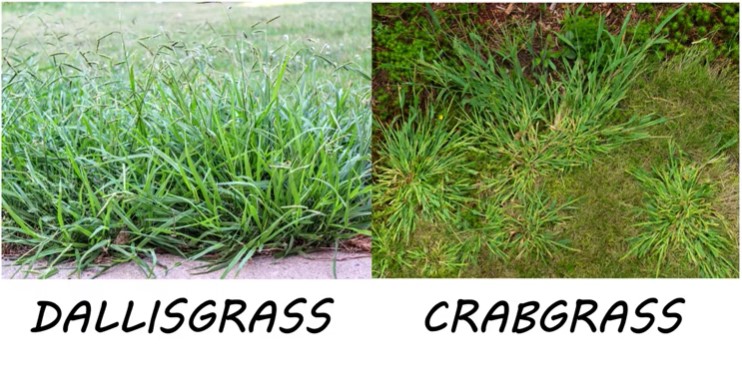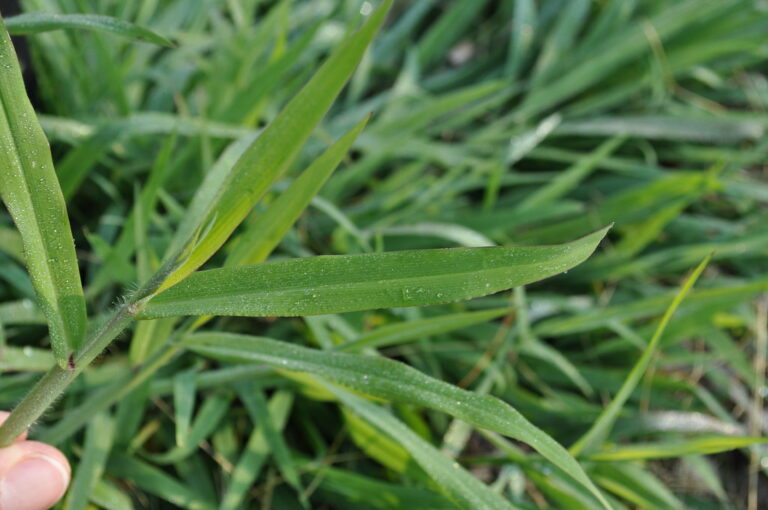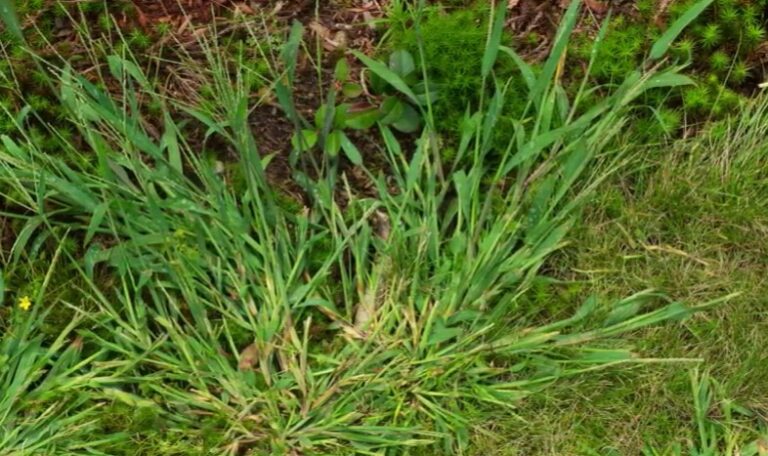- Best Cultivator Attachments Guide - December 23, 2021
- How to Find the Best Leaf Blower Attachment - December 23, 2021
- Best 21 Inch Lawn Mower Blade Options - December 18, 2021
You cannot fight what you don’t know. It’s very interesting to compare two equally irritating lawn weeds, especially to a recreational enthusiast. The difference between dallisgrass vs crabgrass can spell doom to your lawn either way!
It takes all your patience to achieve a golf-course-like lawn, let alone expect an invasion of rapidly growing weeds like dallisgrass and crabgrass. Many trained eyes can quickly pick up the difference from these seemingly similar-looking weeds.
To achieve a lawn with minimal weeds, however, strive to understand how these two pests thrive throughout the season. From the life cycle, organic weed control, chemical control, and environmental conditions.
Let’s compare them for your next lawn planting project, shall we?
Main Differences between Dallisgrass vs Crabgrass
The main differences between Dallisgrass vs Crabgrass are:
- Dallisgrass is perennial and unfazed by seasonal weather changes, whereas Crabgrass is an annual weed that germinates and dies within the same year.
- Dallisgrass has short rhizomes with an even shorter length between stems to the next joint outwardly and vertically growing, whereas Crabgrass keeps to the ground with large leaf blades that grow horizontally.
- Daligrrass needs complete digging if you want to prevent germinating, whereas Crabgrass can be stopped from germinating with the use of pre-emergent and post-emergent herbicides.
- Dallisgrass ensures its survival by easily regrowing from seeds, clumps, and even sods, whereas Crabgrass produces up to 150,000 fertile seeds enhancing its growth potential.
- Dallisgrass only increases the spread of variable parts for further re-growth, whereas Crabgrass grows low against the ground inhibiting successful mowing.
- Diagrams is well adapted for both dry frosty and wet conditions, whereas Crabgrass thrives in dry hot weather
Key specifications of dallisgrass and crabgrass
Looking deep into what set these two weeds apart.
| Dallisgrass | Crabgrass |
| Leaf-blade width: 1/4–1/2 inch | Leaf-blade width: 2/5- to 1/2-inch |
| Soil Type: sandy and heavy clay soils | Soil Type: Sandy Compact |
| Growth Season: All year long | Growth Season: 2 season |
| temperature: 60° to 65°F. | temperature: 55°F |
| Climate: Hot summer and wet spring weather | Climate: Hot dry summer weather |
Core features of the Dallisgrass vs Crabgrass
While a casual glance may see the similarities between these two weeds, they are very different.

Growth rate
Both dallisgrass and crabgrass are rapidly growing pests. However, dallisgrass seeds germinate in both spring and summer, when soil temperatures range between 60° to 65°F. Once germinated, the new clumps thrive in temperatures of up to 80° to 90°F.
What is specifically outstanding is the fact that the rhizomes easily adapt and thrive in wet areas like drainage and heavily irrigated spots.
crabgrass meanwhile will germinate within five days if the temperature remains constant at 55°F. It thrives in the hot dry summer conditions but dies off during the winter frost.
Weed Management
crabgrass can be easily controlled by preventing the germination of seeds. A popular method is using a pre-emergent herbicide to target seed before the shoot gets established.
Post-emergent is an alternative to use if the seeds have already sprouted as it targets the growing crabgrass leaves.
dallisgrass, however, grows both from the sods, clumps, and seeds, making its elimination a lot more complex. Once it germinates, no amount of mowing can exhaustively clear it out. The best weed control is to pull out the grass and let the root dry out. This way, it prevents any re-growth.
Dormancy period
Plants adapt differently to ensure they don’t go extinct, but crabgrass leads the pack. Imagine staying dormant for 3 years before the seeds can germinate! Couple that with 150,000 seeds from single crabgrass and you’ve got a nightmare in your hands.
dallisgrass seed can be dormant during Winter but quickly germinates when the season changes and temperatures hit 60°F. If you choose to target seeds for eradication, therefore, consider mowing frequently to prevent the seeds from dropping to the ground.
Climate and sun exposure requirements
crabgrass loves sunlight and drought-like conditions. When the weather is optimum, it germinates and spreads its nodes like wildfire. The shallow roots quickly suck in any water droplets on the lawn to help it thrive.
To reduce its dominance over your turf, avoid light watering and instead deeply water your lawn until the ground to soak in as much water as possible.

dallisgrass on the other hand enjoys a high water content and does well even in harsh weather. Your best bet would be to prevent the establishment of new seeds and undertake spot weeding.
Foot Traffic
We know crabgrass to create such a close-knit carpet that eludes mowing because of its low-lying nature. It grows with stems generating right from the middle and expands over the ground. While the center of crabgrass may die out, the stems keep it going. Making it hold well to high foot traffic.
Dallisgrass vs Crabgrass–Pros and Cons
Dallisgrass Pros
- Controlled by proper mowing techniques like pulling them out.
- Over-seeding bare areas of the lawn can reduce new invasion.
Dallisgrass Cons
- Easily infected by ergot fungus that is poisonous to livestock
- Produces ugly clumps that interfere with recreational areas like golf courses.
- Competes with your lawn turf for nitrogen fertilizer
- Well adapted for both wet and dry weather, making it difficult to control
- Can only be eradicated by pulling out each grass, a task that is labour intensive
Crabgrass Pros
- Seeds easily die during winter/frosting conditions
- Causes no harm to your lawn except being a nuisance
- Easy to end because of its short lifestyle
- Capable of withstanding heavy traffic
- Using both pre-emergent and post-emergent methods can clear the weeds out!
Crabgrass Cons
- Ugly and destroys the lawn aesthetically
- Grows rapidly and infests spaces within your lawn grass
- Tougher to mow as it lies lower to the ground and spreads horizontally
- Survives in hot, dry weather conditions.
How To Manage Dallisgrass vs Crabgrass
Management of both weeds requires proper timing, use of both herbicides and better lawn management techniques. Feel free to use both organic and chemical methods.

The first rule of the thumb is to choose suitable weed eradication methods for your lawn. Consider organic approaches like;
- Identification of the life cycle of both weeds. Controlling weeds before they germinate or drop seeds to the ground is your best bet. This eliminates countless wasted hours and dollars in dealing with the weeds.
- Mowing appropriately to target your weed of choice. You want to mow at 2- to 3-inch height to keep the sunlight from reaching crabgrass. Shade prevents it from thriving.
- Fill up your lawn with a dense tuft to choke and limit the expansion of crabgrass and dallisgrass.
- Over-seed any bare areas within the lawns. These are the elephants in the room! Bare grounds provide space for both weeds to let loose and destroy your creative work. Whenever you use herbicides and bare spaces develop, quickly fill them up with new sods or seeds.
- Manually pull out the stubborn weed and make sure that the roots dry out. Leaving them with a patch of soil will only encourage more growth.
- Avoid cross-contamination of your lawns. Make it a routine to clean your tools and equipment after working in a dallisgrass invested area. The pesky weeds easily get transferred from one area to another by animals, wind, and farm tools.
Organic methods can work only so far. To save an extreme invasion, opt for chemical treatment.
While there are many herbicide options on the market, choose the ones that will do less harm to your lawn (desirable grass) or other ornamental plants you grow.
Read our full guide on how to find the best crabgrass killer.
Use Selective Herbicides
Choose a chemical like Tenacity Turf Herbicide – 8 ounces which is an excellent choice for both pre and post-emergent crabgrass management. Young shoots suck in tenacity from the soil, making it ideal for weed eradication.
Mix Herbicide To Your Fertilizer
Fight off weeds right at the point you establish your lawn. A mix of Tenacity to your fertilizers will give your lawn a head -start against several weeds. Couple this with proper irrigation and a tight-knit turf, and you eliminate crabgrass infestation.
Spot Weeding
Target dallisgrass and kill them with Roundup Ready-To-Use Weed & Grass Killer III with Comfort Wand which has glyphosate as the only active ingredient. Be very cautious when spot treating dallisgrass though because the grass will not be spared either.
Remember to use a 1- or 2-gallon tank sprayer to this task. A quick heads up! Unlike other herbicides, glyphosate does not contaminate your lawn and the burnt grass will quickly recover.
Alternatively, you can plant new sods in the area left bare after the spot treatment. We don’t wish to leave a weak spot for weeds, do we?
FAQs
Answer: Crabgrass has two species. A small, smooth and hairy, large species. The shallow-rooted crabgrass develops several stems, forming clumps with broad leaves small, spread over the ground. These stems grow outwards from the middle of the plant, forming crab-like legs.
Answer: No. dallisgrass depends not only on seeds to propagate. New shoots easily germinate from sods and the stem. It, however, produces countless seeds per plant that are all viable. This makes killing it difficult.
Answer: Yes, it is. However, this process requires timeliness, the right techniques and a lot of patience. Timing when dallisgrass is vulnerable, making the growth environment unfavourable and constantly mowing your lawn will produce the desired result.
Answer: Fortunately, your precious lawn can be salvaged by spot weeding. Choosing a herbicide with a non- contaminant element like glyphosate not only guarantees selective weeding, it also enhances the growth of your lawn tuft, in a short period.
Answer: No! Most plants are susceptible to diseases, and that applies to dallisgrass. It is easily infected by ergot fungus, which is poisonous to livestock.
Answer: Some herbicides used for crabgrass elimination like prodiamine pre-emergent herbicide works well for dallisgrass. However, repeated treatment is necessary to achieve a weed-free lawn.
Summary: Crabgrass vs Dallisgrass
It’s annoying to put up with weeds on your beautiful lawn. However, to effectively eradicate either crabgrass or dallis grass, get to know their difference.
This will spare you the agony of attempting to eliminate weed grass using the wrong products. Pay attention to the life cycle of the weeds, their characteristics, and their weaknesses.
Be intentional about your approach to weed eradication and take advantage of environmental conditions that favor you. For instance, it is counterproductive to apply herbicide during a rainy season, as this will wash off the chemical before absorption.
Ensure that you deny the weeds a thriving atmosphere that encourages time-consuming growth. Instead of sunshine, introduce a shade over crabgrass by moving your lawn 2-3 inches above the ground.
While a more permanent weed eradication method may be labor-intensive and time-consuming, it is worth it eventually. Pull out weeds and dry out their seeds before they release them to the ground.
Above all, to achieve a lawn free of lawn weed varieties, you must exercise a high level of dedication and patience. Seeds can remain dormant for several years before they germinate. Work within this period towards a permanent weed eradication plan.
Provide your lawn with timely fertilizer and water cover to encourage lush growth. These will prevent crabgrass and dallisgrass from taking root in the first place. Eliminate open spaces within your lawn and mow to the right size to give your turf a fighting chance.
Both weeds can be a thorn in the flesh. Equip yourself with the right knowledge and best practices for your lawn to enjoy the most beautiful lawn you envisioned.
Was our Dallisgrass vs Crabgrass perennial weed comparison helpful? Leave a comment and let us know.
Further Read on Grass Types, Weed Killer, and Lawn Weed Control:

